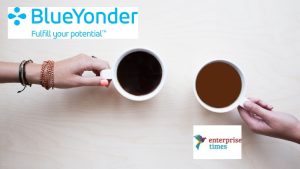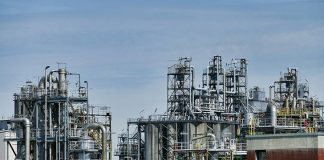
Who is Blue Yonder?
“Blue Yonder is the world’s largest digital fulfilment cloud company. We enable organisations across multiple industries to predict, pivot and fulfil consumer demand wherever it happens.“

Blue Yonder was formed when JDA Software rebranded itself as part of an image change in February 2020. Originally Blue Yonder was an acquisition that JDA made in 2018. JDA was the leading solution in retail and fulfilment technology. The company is growing rapidly, adding 47 new customer logos in Q3 2022 and is a leader in several analyst reports. These include the 2022 IDC MarketScape for Worldwide vendor assessments for Holistic Supply Chain Planning, Supply Chain Inventory Optimization, Supply Chain Sales and Operations Planning 2022 Vt, and Supply Chain Demand Planning 2022.
How big is Blue Yonder?
“We have over $1 billion in revenue and over $500 million in annual recurring cloud revenue, so it’s a genuine cloud company. The interesting thing about the space we’re in is that we’re the only massive billion-dollar scale company in the supply chain. Most of our competitors are point solutions in planning, warehousing, or eCommerce order management. We have 6,000 Associates (employees) and almost 4,000 customers.”
Where is the Blue Yonder strategy
What does the future hold for Blue Yonder?
“The opportunity here is to be the dominant category player in supply chain management and eCommerce. There’s no other multibillion-dollar scale like this. Continue to accelerate everything that company is doing. It’s been growing, cloud bookings at a double-digit basis, even before I got here, for the last two or three years.
“Then, much like I’ve done in my other companies, we’re going to accelerate the pace of innovation. I’ve always believed that if you get the product right, everything else takes care of itself.
“What Blue Yonder does is absolutely mission critical. If someone’s CRM system goes down and a sales rep can’t update their pipeline, the world doesn’t stop. If someone can’t ship a product because their warehouse is down, you get a phone call.
“We are held to a much higher bar relative to other enterprise software companies given our service. We run people’s warehouses, transportation fleets, and the order management behind their eCommerce site. It’s absolutely mission critical, even more so given what’s going on around the world.”
This was put in perspective in an anecdote that Angove related. The manufacturer and distributor described the warehouse as the business’s heartbeat. The customer said to Angove, ‘Duncan, we’ve given you our heartbeat.’
Angove concluded, “What we do is so darn important.”
What is digital fulfilment?
There are some big eCommerce and ERP companies out there that cover elements of the supply chain and have warehouse management systems. There are also networks such as Ariba and Infor Nexus. What’s the scope of digital fulfilment?
“Today, one of the things that makes Blue Yonder unique is the breadth of our footprint. Almost every single competitor we have is a point solution. You reference the ERP guys. Yes, they have functionality for some of these areas. But the supply chain is so important that a business makes a best-of-breed decision almost every time. The numbers and the importance of the supply chain are just too important to leverage a generic ERP, where it’s not the best in class.
“We have the broadest footprint of supply chain. We go all the way from the factory to the consumer. We do the predicting and planning of that demand and supply. We support all the execution through transportation, which is the first mile, middle mile and last mile all the way to the consumer, and then all the warehousing that sits behind that.
“When you get closer to the consumer, we do all of the order orchestration and order management across that network that extends from the consumer all the way back. No one else does that and sits across all of it. We have a control tower that gives you visibility to what’s going on at any point in time.”
On partnerships
You have partnerships with Microsoft and Snowflake but not with the big ERP vendors. Do you partner with them? How do you work with them?
“We don’t work with any of them today. But you’re right; a lot of the companies we work with use SAP and Oracle. So, we do integrate with them, and we’ve integrated them thousands of times. But we don’t have a go-to-market partnership or anything like that with them.”
Is that likely to change?
“We’re looking at all of that. It’s too early for me to say.”
On Panasonic
One of the partnerships we haven’t mentioned is the one with Panasonic. What are the synergies that you see between Blue Yonder and Panasonic, now the dust has completely settled on that acquisition, and where are the benefits to both sides?
“First of all, everyone knows that almost every company out there is turning into a software company, particularly the large industrial or consumer goods companies. What better way to understand digital transformation and how it’s transforming those traditional businesses is by owning a digital software fulfilment company?
“The second is we’re implementing our software across different aspects of Panasonic. For example, in the US, we’re implementing a control tower for the Panasonic business. They provide a lot of batteries for electric vehicles. In Japan, we’re doing a similar thing.
“Thirdly is that I talked about going from factory to consumer. There’s this notion of the edge, where all the sensors and IoT devices sit. This could be instrumenting trucks, a warehouse, or a factory and then leveraging those real-time sensor inputs back into the supply chain to drive real-time decision-making driven by the digital pulse at the edge. That’s probably the most exciting thing between Panasonic and Blue Yonder.”
Are you learning from Panasonic as well? Those edge devices are not just providing information into the supply chain knowledge. They’re also providing information into the design and manufacturing processes, as well.
“That’s correct. The Japanese manufacturing and supply chain practices led the world: the Toyota Production System, lean manufacturing, Six Sigma, all of that. A lot of the Panasonic factories have already got sensors in. They’ve even got cameras with computer vision. From the factory floor, we used to do more static-type planning. Now you can make it much more real-time and integrate that back into the Blue Yonder suite.”
On product and acquisitions
Do you have any plans to extend the functionality of the platform? You’ve mentioned investment organically, but what about inorganically?
“Yes, absolutely. I would say that if you think about the last two acquisitions that we made, the first was the original Blue Yonder company in Karlsruhe, Germany, where it acquired an incredible amount of talent around AI and ML and rethinking how you can forecast demand and orchestrate it using AI, which really made the company leap forward.
“And then the second is the Yantriks acquisition, which was the biggest surprise to me upon joining Blue Yonder. The company is not well known for commerce and order management, and it is a staggeringly impressive set of capabilities. And, having spent 30 years in retail and eCommerce, I know what good looks like. I was blown away by what I found. You can see it by the quality of customers signing up for it, the recent win at Asda, for example.
“We are going to dramatically accelerate both the roadmaps and the pace at which we analyse, buy versus build. And accelerate the roadmap not just in terms of the capabilities we already have, but to extend it in ones that are very complementary to supply chain and eCommerce.”
On the future
What do you hope to achieve in the next six to 12 months?
“Continue to serve our customers and take advantage of this zeitgeist moment in supply chain and commerce worldwide. So, continue to grab that opportunity and grab market share and grow our fulfilment cloud.
“Second, working in hand with Panasonic is to dramatically accelerate the pace of innovation on all of our roadmaps. I did the same thing at Infor. We looked at roadmaps that were two years out. And we said, how do we surge on that and deliver it in six months? How do we challenge conventional thinking around how supply chains and eCommerce have always been done? Then use acquisitions to help complement that acceleration, which to me will be winning new customers, doing a great job in serving the customers that we have, given the importance of what we do for them, and then dramatically accelerating the pace of innovation.”
In a few years, what will success look like?
“The North Star is that we are known as the operating system for commerce around the world, that extends from the factory all the way to the consumer. And where commerce occurs, whether it’s a traditional supply chain between two businesses or commerce between a company and a consumer, the fabric of commerce, trade, and eCommerce runs on top of our operating system. There’s almost like this mesh that circles the globe, and we’re known as the company that facilitates and orchestrates commerce wherever it takes place. That, to me, would be great. That we have happy and empowered Associates and a great reputation in the market, and companies worldwide rely on us.”
Moving to the cloud
In terms of moving to the cloud, how will you accelerate that move?
“We have over 600 customers in the cloud today and it was done in three years. The thing that surprised me is, given its real-time nature and mission criticality, you would have thought they’d be resistant to moving supply chain to the cloud. Actually, there hasn’t been at all, which was a pleasant surprise to me. There haven’t really been any barriers to it.
“The demand for Supply Chain Solutions is really strong. It’s come to the top of almost every company’s IT and technology budget. They all know that software solutions built 20 years ago to manage those supply chains aren’t going to be the ones they need going forward. That’s not just because of the focus on the last mile and eCommerce’s impact on this. Even if you’re a manufacturer trying to get your arms around direct to the consumer when you’ve got a supply chain that was built to send pallets downstream, and now you’re shipping singles to consumers. It’s everything else, it’s resilience, and what does just-in-time mean in this world? How do I get my arms around sustainability and all the regulatory reporting that’s coming out around that?
“There’s so much in flux, and customers in the market view Blue Yonder has the brand authority on the supply chain, given how long we’ve been in it. We’re often brought in for more strategic conversations that end up implementing technology to deliver the joint strategy that we’ve come up with them.”
Are there really no barriers to moving supply chain to the cloud? Surely the first 600 were the low-hanging fruit?
“There’s some validity there, and I’m not implying it’s easy. The challenge we had at Infor is that because it was an industry and a micro-vertical-based solution, there were tonnes of customisations preventing companies from moving to the cloud because you can’t customise the source code in the cloud.
“Supply chain is not dissimilar, particularly in the warehouse management space. You just have to look at a large publicly traded WMS company in that space, and it’s mostly services revenue. There’s still an education process in certain categories of supply chain with companies to say, don’t customise it.
“We know the best practices for running this warehouse. A big part of the Blue Yonder strategy is to deliver digital fulfilment clouds by industry, called industry clouds. We’ve got ones for consumer packaged goods, grocery, and high-tech. Those have, as they had at Infor, pre-packaged functionality for that vertical, all the integrations you need, including SAP and Oracle. All the reporting you need and so on will make it easier for people to take an out-of-the-box fulfilment solution for their industry. Obviously, you have to build extensibility into it so that without customising it, you can extend it where you need to, given a company may have a certain nuance to how they run their supply chain.”
Challenges
What are your challenges?
“It’s like everyone. It’s the war for talent. Put aside remote work and how the workplace is changing. The benefit we have is we’re a company on an IPO track. It is obvious to everyone that we should be the next Workday, ServiceNow, and Salesforce, so that excites people. We generally bring people here where it’s not just that you’re joining a super interesting rocket ship in a super hot category but can also be purpose-driven.
“Supply chains throw up a huge carbon footprint. How can we build a really cool company but at the same time save the planet? We have an advantage there, but like everyone, we’re trying to be a great place to work. Then, as I said, it’s accelerating innovation and challenging conventional thinking. Being courageous and bold with the market and our customers around, having them reframe how they think about what a supply chain should look like now.”
The book question
What’s the latest book you read? And what was your take out for business from it?
“The latest book I read was actually called The box (by Mark Levinson, Amazon AUS, UK, US). It sounds a very nerdy book to read, but I’m a supply chain geek. It’s the history of the shipping container. What I love about technology, and you wouldn’t think of the shipping container, is technology, but it is. McLean invented it in the US, and it was a standard shipping container box that could go on a lorry, train, or ship. It transformed the way the world conducted trade. It used to take hours and hours for labourers at ports to unload all the stuff off the ship. It dramatically transformed that industry and wiped out 90% of all the labour required.
“It also meant the second-order consequence of you no longer needing factories and manufacturing located close to the ports. They could actually move inland because now you can very quickly move them. This idea that this technology, this global standard, came along and transformed the way trade happens.
“The takeaway would be the transformative impact that technology can have. Not just where you can see it immediately but all the second-order consequences of it. Who would have predicted that this shipping container would come on and suddenly, the heartland of America would become a manufacturing base? No one knew that the invention of the car would create suburbia or Walmart. That was a fascinating book to read. Maybe that’s a message around not modifying code!”


























